Vintage Treasures: Orphans of the Sky by Robert A. Heinlein
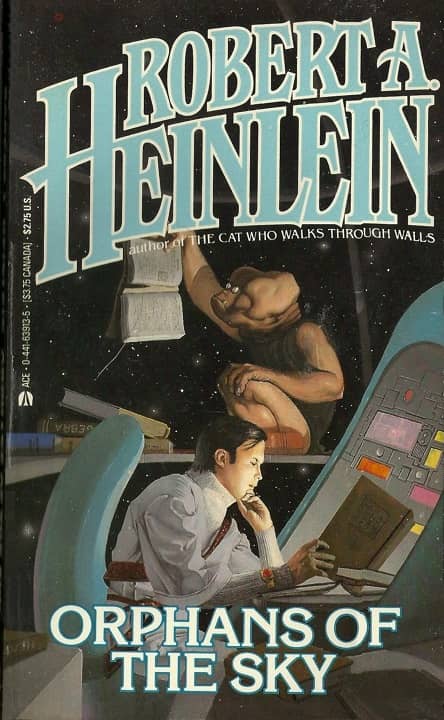 |
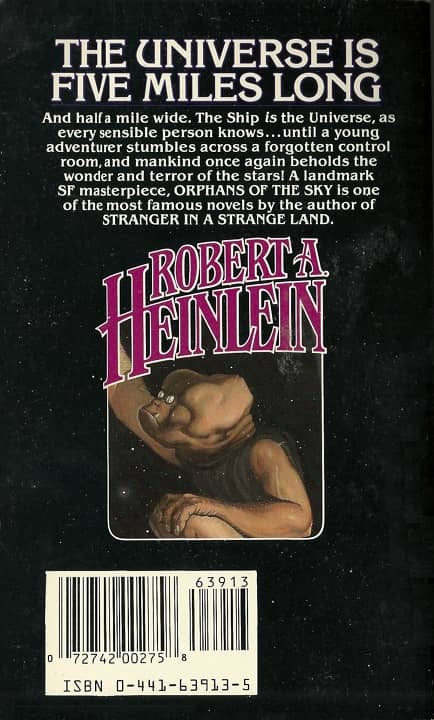 |
Orphans of the Sky (Ace Books, 1987). Cover by Carl Lundgren
Robert A. Heinlein never really did it for me. Even in my teens, when I was devouring any science fiction between covers, I didn’t get the appeal. I never read his juveniles, and I bounced hard off of Friday. I found Stranger in a Strange Land dull and unbelievable, and The Moon is a Harsh Mistress resisted every attempt I made to get past the first 20 pages.
Why’d I make so many attempts? Because the first Heinlein I ever read, the slender paperback novel titled Orphans of the Sky, was a slam-bang adventure tale set on a six mile-long spaceship that twisted my head around. It was packed full of interesting characters and genuine surprises, and fit in well with the pulp SF by Asimov, Charles R. Tanner, and Edmond Hamilton — and movies like Star Wars and Alien — that was filling my head up at the time.
Orphans of the Sky fit the mold of pulp SF because it was pulp SF. It was originally published (as two separate novelettes, “Universe” and “Common Sense”) in Astounding Science Fiction in 1941 and follows the adventures of Hugh Hoyland, a scientist’s apprentice on the enormous generation ship Vanguard, whose inhabitants have long since forgotten their origins. When Hugh is captured by mutants and begins to learn the true nature of the Vanguard, he leads an onboard mutiny that changes the fate of everyone.
[Click the images for generation-ship sized versions.]
Astounding Science Fiction, May 1941. Cover by Hubert Rogers
The concept of a generation ship wasn’t new even in 1941, but Heinlein married the idea with a fast-paced and absorbing pulp adventure story, and a well-thought out depiction of a degenerate society in an enclosed and decaying environment.
The tale is rightly considered a classic. Damon Knight, a clear-eyed critic of early SF, said “Nobody has ever improved on “Universe,” although a good many reckless people have tried, because Heinlein said it all.”
That may be a little harsh. I’ve read my share of generation-ship SF, and I certainly wouldn’t consider all those attempts reckless. I wouldn’t say it constitutes a thriving sub-genre, exactly, but there’s certainly enough examples to make a decent reading project. Surveying the field in Galaxy in 1966, Algis Budrys generally seemed to agree with Knight, writing “Many hands have worked at improving Heinlein’s impeccable statement of this theme,” and he noted that none really succeeded until James White’s The Watch Below.
Universe chapbook (Dell, 1951). Cover by Robert Stanley
Most of Heinlein’s work stayed in print for decades, and Orphans of the Sky was no exception. The first half (“Universe”) was reprinted by Dell as a paperback chapbook in 1951, a fairly collectible little item that’s worth keeping an eye out if you’re a paperback collector.
“Universe” and “Common Sense” were first brought together as Orphans of the Sky by Gollancz in 1963, and first appeared in paperback in the US in 1965 from Signet.
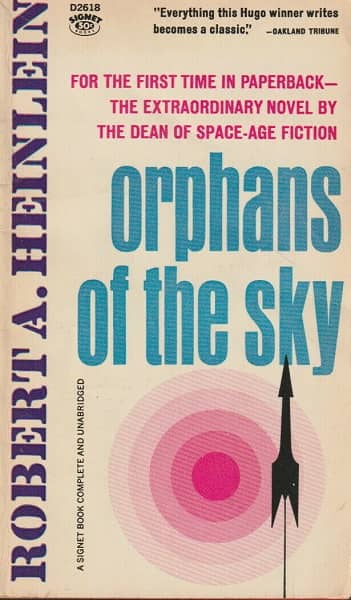 |
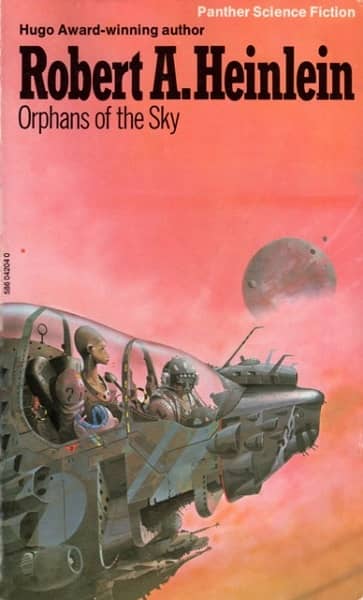 |
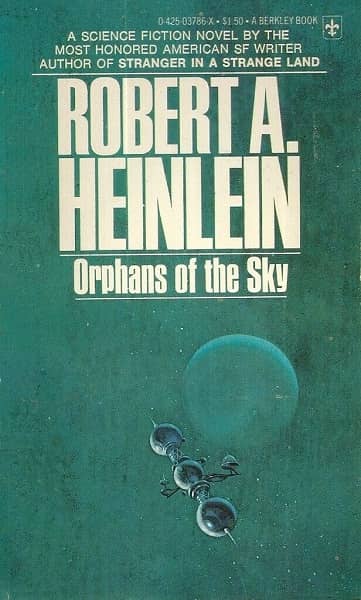 |
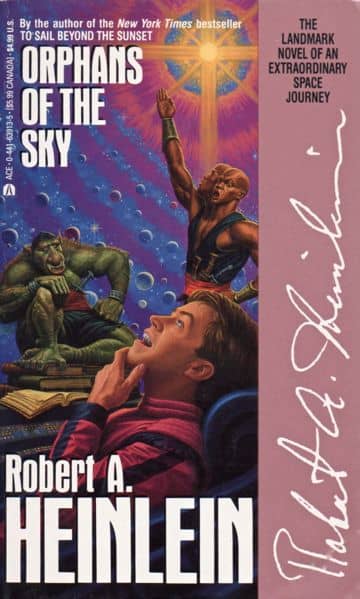 |
Assorted editions of Orphans of the Sky: Signet, 1965 (artist uncredited),
Panther 1975 (Peter Jones), Berkley Medallion (1970, uncredited), and Ace Books (1992, James Warhola)
Since 1965, Orphans of the Sky has been reprinted numerous times by over a dozen publishers, including Signet, Mayflower-Dell, Panther, Berkley, New English Library, Ace, and most recently by Baen in 2014.
The one I read was the 1967 Signet edition, which I found in a used bookstore in Ottawa in the mid-70s. It’s famous for the botched description on the back of the book, which was clearly intended for a different Heinlein novel.
The notorious 1967 Signet edition, with the wrong description on the back.
Cover by Sidney Kramer. Photo by Patrick Nielsen Hayden.
I’m generally in a minority in my opinion of Robert A. Heinlein among old-school SF fans, and his reputation (particularly for his early work) has remained strong. It has certainly endured longer than virtually all of his contemporaries anyway, even the other two of the Big Three (Asimov and Clarke).
I’ve noticed this changing in the decade or so. Even Heinlein’s enduring place on bookstore shelves isn’t permanent, apparently, Without a significant film property to help promote his catalog to modern readers, he may be totally out of print in a decade or so.
While the vast majority of Asimov and Clarke’s work (unlike Heinlein’s) been out of print for years, I see no sign of Asimov’s Foundation or I, Robot being soon forgotten. In fact, the upcoming Apple TV Foundation series may bring Asimov back onto bestseller lists (again), more than a century after he was born.
If I were a betting man, I’d bet Asimov will endure longer than Heinlein, for a number of reasons. I’m looking forward to finding out if I’m right in the next few decades.
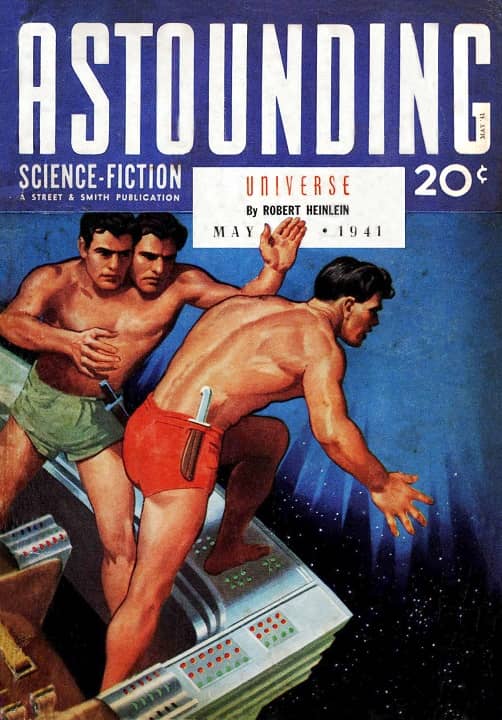
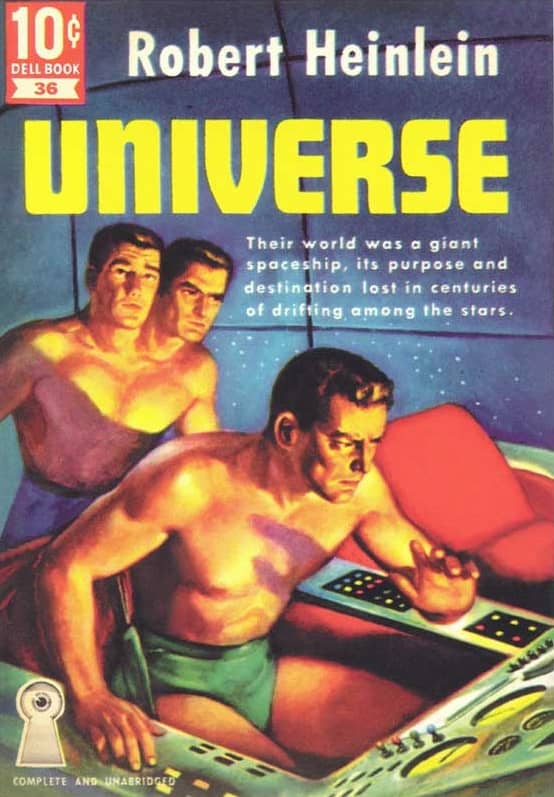
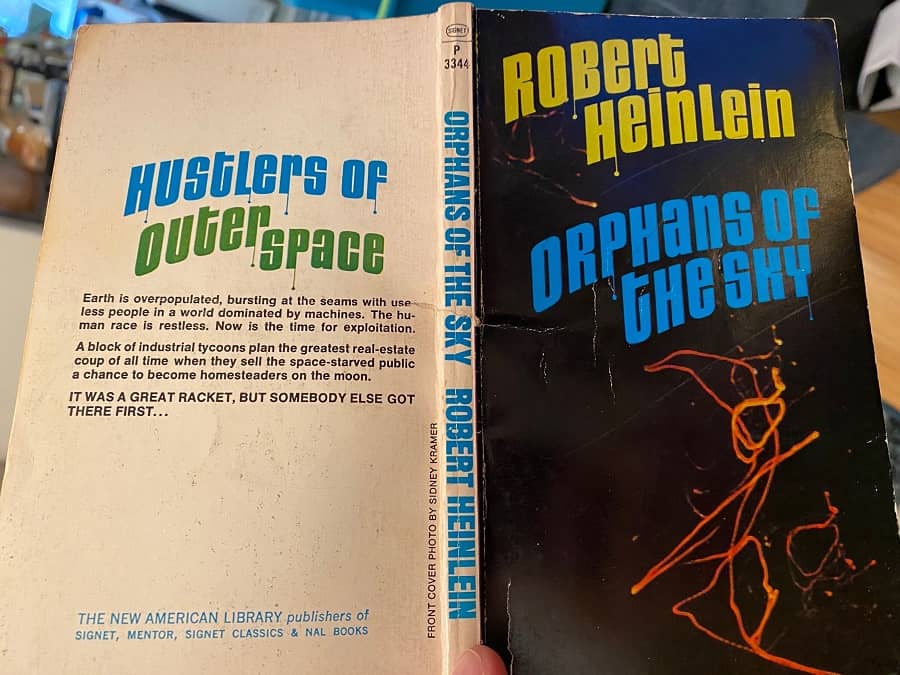
“Without a significant film property to help promote his catalog”…
You mean like Starship Troopers?
I just remember there being plenty of contemporary SF writers around in the 70’s and 80’s (not to mention authors who’d started out in the 60’s) – so much so that there wasn’t any incentive to read the ‘golden age’ generation, many of whom had a slightly stale, stodgy whiff about them even then. Heinlein was a prime example.
Heinlein was my gateway drug (via Dad’s copy of Red Planet), along with John Christopher’s Tripods books, and I do still enjoy his work very much from time to time, but yeah, it’s not something I’d be giving to new readers to pull them into the field these days.
Damn! Can we get some RAH love around here? (And John, RAH “never really did it” for you?! Expect to hear from my lawyer; I have to get out of this relationship.)
Picking up a used paperback of Have Space Suit, Will Travel was literally a life changing moment for me, and I will still defend the freshness, inventiveness, confidence (cockiness, even), and energy of the juveniles to the death, against anyone. Alone they constitute one of the most important contributions to modern sf by anyone, ever. Anyone who picks up (to name just a few) Have Space Suit, Red Planet, Space Cadet, or The Rolling Stones will have a blast. If you’re not susceptible to the charm of those books, you’re impervious to sf altogether.
Add the best of his adult work – The Door into Summer, The Puppet Masters, Double Star, The Unpleasant Profession of Jonathan Hoag, along with some great short stories, and you have a true giant.
Stale and stodgy? The man who was had his male space cadets wearing makeup when Eisenhower was president, who was writing about group marriages in the 50’s?
I respect Asimov, but I’d rather read prime RAH any day of the week. Is he “cutting edge” anymore? Of course not, but then neither is anyone who published anything more than six months ago. Reading RAH at his best (which is how every writer deserves to be judged) was like getting a letter from a pen pal who lived in the future. I couldn’t wait to read those letters back when they were new to me, and I still get a great deal of enjoyment from revisiting them, even today, and I wouldn’t hesitate putting one in the hands of anyone in 2021 who just wants to read a terrific story.
So there!
I love most of RAH’s novels and shortstories. As a teen who had just discovered the sci-fi cornucopia, Orphans of the Sky impressed me enormously. It moved me, I found the story quite tragic! But I suspect that head honcho William Campbell of Astounding Science Fiction magazine where Orphans premiered, one day said: “That’s enough, finish it!” and the finale is indeed noticeably rushed.
Heinlein is said to have done a rewrite in the early fifties, but I never found it.
I have that copy in my Very Hallowed RAH (almost) complete collection (including a hard bound “Grumbles From the Grave” with an intro by Virginia). His stories inspired me to set out on my own penned adventures! Long live the tales of RAH!!
Aren’t you lucky! But if it wasn’t for Internet, I would know nothing.
> You mean like Starship Troopers?
chartmapcounter,
Maybe I should have qualified that to say successful film properties. 🙂
I’m a fan of Starship Troopers, but it was a significant money loser for Sony. It cost $105 million, and total domestic box office (split roughly 50/50 with movie theaters) was an anemic $54 million. Even including international receipts only brought it up to $121 million.
Even if you consider Starship Troopers a success, it was released 24 years ago. That’s a looooong time between major Heinlein film properties.
Anyone know of anything major in the pipeline? Heinlein has an impressive catalog; I’d love to see a film version of Double Star, for example.
> I just remember there being plenty of contemporary SF writers around in the 70’s
> and 80’s… there wasn’t any incentive to read the ‘golden age’ generation
Aonghus,
That may have been true, but at least they were in print. Much of Asimov and Clarke’s output remained available on bookstore shelves through the 90s, and Heinlein was kept in print by Baen for another decade, at least.
It seems to me that only on the last few years has it become tougher to find anything by the big three routinely available. Foundation, maybe?
Quite a few of the authors I did end up reading have long since vanished off the bookshelves! (Philip Mann and Michael Swanwick, to cite two examples off the top of my head) but yeah, I think there are sudden seismic shifts in popular culture that catch you unawares. A certain actor seems to have been around forever, he’s a household name etc – until suddenly he’s not. I’ve had conversations with twenty-year-olds who’ve never even heard of Paul Newman, let alone seen one of his films. The foundation series is still in my local bookshop though. My brother bought me the first three for Xmas a while back. Ironically I read a lot of Asimov’s short stories as a teenager, but never any of his longer work. As for Clarke: sometimes a writer’s entire oeuvre is whittled down to just one or two books and Clarke seems to be a case in point.
It’s hard to know what your average modern teenager would make of either author. Very few writers age well, although I can appreciate how they might have a special place in the hearts of those who read them while still young and when those authors were still current. Somebody recommended a collection of Heinlein’s short stories on this site a while back. I tracked it down and started reading it, and don’t think I ever finished it. I just found it really heavy going.
Re: Heinlein movie adaptations – Heinlein’s time-travel paradox short story “… All You Zombies…” was made into the movie Predestination starring Ethan Hawke in 2014. It premiered at the SXSW Film Festival in Austin, TX. Not a success at the box office, though ($5.4 million on a budget of $5 million).
The Puppet Masters was also filmed – wretchedly. Maybe the moral is that when you do film a classic author, make the movie a good one instead of a crappy one.
whoa… WHOA
for those of us that LIKE bad movies, The Puppet Master is… one of them!
I’m 56 and I’ve never seen a Paul Newman movie…
I think no SF story ever blew me so away as ‘Universe’ did. The worst thing about getting older is losing that Sense of Wonder.
Anyway, I’d rate Heinlein as one of the most versatile writers of speculative fiction of his generation, with only Fritz Leiber as equally or more so. The first part of ‘Gulf’ is some of the best spy stuff I’ve read, for example.
I’ve only read his stories up to and indluding Starship Troopers, though. I think Heinlein’s reputation today rests mostly on the stuff he wrote from there on. And I regret never getting the chance to read his juveniles when I was a kid. But I still enjoyed ‘Citizen of the Galaxy’ and a couple of others well enough as an adult.
Orphans of the Sky is one of my all time favorites. I enjoyed all of Heinlein’s juveniles and when my son needed to do a book report (he was never a reader) I read Orphans of the Sky to him and he liked it and did the report. He really liked the Starship Troopers movie but never tried the book.
Speaking of film properties…on YouTube you can find the animated Red Planet from 2994. You can almost tell it was based on the book. My son was 8 when it was first broadcast but it never got his attention.
Their doing a complete reboot of Starship Troopers.
https://www.hollywoodreporter.com/heat-vision/starship-troopers-reboot-works-943882
They’re. God, I hate autocorrect.
> Heinlein was my gateway drug… but yeah, it’s not something I’d be
> giving to new readers to pull them into the field these days.
Joe,
I may be the only one who remembers, but in the 90s Tor tried to replicate the success of the Heinlein juveniles, publishing a series of juvenile-aimed SF in hardcover. The theory being that Heinlein had drawn an entire generation into SF in the 50s and 60s, but there was no recent comparable publishing effort.
They released a handful of novels by a few well known names, and then quietly retired the imprint.
The opinion that Heinlein juveniles have no appeal to a modern audience seems almost accepted as fact nowadays, but I dunno. Anyone have a different opinion?
> I will still defend the freshness, inventiveness, confidence (cockiness, even), and energy of
> the juveniles to the death, against anyone. Alone they constitute one of the most important
> contributions to modern sf by anyone, ever. Anyone who picks up (to name just a few) Have Space Suit,
> Red Planet, Space Cadet, or The Rolling Stones will have a blast. If you’re not susceptible to the
> charm of those books, you’re impervious to sf altogether.
>
> Add the best of his adult work – The Door into Summer, The Puppet Masters, Double Star, The Unpleasant
> Profession of Jonathan Hoag, along with some great short stories, and you have a true giant.
Thomas,
Glad to see someone defend the legacy of the Heinlein juveniles!
Years after I got into SF I remember someone describing RED PLANET and being shocked to find I had read it in my youth, but totally forgotten the title and author. Only a few scenes had stayed with me (most notably, a young woman who falls asleep inside some kind of killer plant on Mars, and only survives because she left her flashlight on).
I’m intrigued by your list of Heinlein’s best. Mostly because I haven’t read any of them. 56 seems like a strange age to start reading Heinlein (especially in 2021), but maybe I really did miss out on reading his best work, and should give him another try.
I WAS always curious about DOUBLE STAR….
> Somebody recommended a collection of Heinlein’s short stories on this site a while back. I tracked
> it down and started reading it, and don’t think I ever finished it. I just found it really heavy going.
Aonghus,
Do you mean THE PAST THROUGH TOMORROW? Interesting you should mention that. I’m planning to do a VINTAGE TREASURES article on it in the coming weeks, mostly as a counterpoint to this post. While I had no real success with Heinlein’s novels, I almost always enjoyed his short stories, and think they deserve to be preserved.
Mind you, your comment “I just found it really heavy going” is pretty much the reason I never attempted to read THE PAST THROUGH TOMORROW all the way through. It’s such an hugely ambitious book, a true Future History (with all that entails), and I’m not sure I ever felt sufficient energy to plow through all 830 pages of the damn thing. But I do like to dip into it occasionally!
> Heinlein’s time-travel paradox short story “… All You Zombies…” was made into the movie Predestination…
> Not a success at the box office, though ($5.4 million on a budget of $5 million).
Eugene,
I still remember watching the trailer for Predestination and twigging to the source material only at the end, when Ethan Hawke whispers, “I know where I come from… where do all you zombies come from?” A cool moment.
https://www.youtube.com/watch?v=UVOpfpYijHA
But yeah. Not a successful film by any means, and I doubt most Heinlein fans even know it exists. I liked it, though I could never figure out the motivation for the Fizzle Bomber.
> whoa… WHOA
> for those of us that LIKE bad movies, The Puppet Master is… one of them!
Dante,
Right?? I actually kinda liked The Puppet Masters! But I never read the book, and I hear those who did hated it (along with lots of people who DIDN’T read the book). But Donald Sutherland was great as The Old Man.
> I’m 56 and I’ve never seen a Paul Newman movie…
Jeff,
Not even Cool Hand Luke, Butch Cassidy and the Sundance Kid, or The Sting?? The Sting is my favorite — watch that one as soon as you can!
He also played Doc Hudson in Pixar’s Cars.
> I think no SF story ever blew me so away as ‘Universe’ did. The
> worst thing about getting older is losing that Sense of Wonder.
Knut,
It definitely had a huge impact on me. I’ve been toying with the idea of doing a reread of the books that first introduced me to SF (including Simak’s Shakespeare’s Planet, Perry Rhodan, The Hugo Winners, and Orphans of the Sky), and Orphans would definitely be a highlight in that project.
> I regret never getting the chance to read his juveniles when I was a kid. But I still enjoyed
> ‘Citizen of the Galaxy’ and a couple of others well enough as an adult.
Glad to hear that! Maybe it’s not too late to try a few of his juveniles…
Nope.
https://www.blackgate.com/vintage-treasures-nightfall-and-other-stories-by-isaac-asimov/
Sorry, RK!
I should add that I have a work colleague around ten/fifteen years younger than me who’s a big Heinlein fan, so Bob’s long, slow slide into literary obscurity isn’t a given. Yet.
The three books I mentioned – Double Star, The Door into Summer, and The puppet Masters, are, I think, by far RAH’s best adult novels. (The Unpleasant Profession of Jonathan Hoag is a novella.) They were published together many years ago as A Heinlein Trio; it may have been a book club book.
They are all vastly entertaining. Double Star is Heinlein’s most humane story, Door into Summer is an ingenious time travel yarn that I think would make a great movie (though it’s not without a note of the creepily incestuous solipsism that emerged in his work as the years went on) and Puppet Masters is (along with Who Goes There and Invasion of the Body Snatchers) sf’s greatest paranoid tale of alien invasion and infiltration.
Heinlein may be going out of print at the moment, but I wouldn’t bet on his staying there for long; he was just too damned good a storyteller.
Aonghus,
Ah, THE GREEN HILLS OF EARTH!
At least you knew it was a collection. For most of the last 40 years I thought that was a Heinlein novel!
I love the book covers by Hubert Rogers and Robert Stanley. 1940’s sci-fi
pulp art was amazing. Women based on 1940s Hollywood pin-ups in avant-la-lettre miniskirts and Madonna-Gaultier bras, very futuristic. The male space heroes were usually bare chested (shaven/waxed) and in briefs. The artists were probably inspired by Flash Gordon and the superhero comics of that era.
The swim briefs here may even be practical, on board of generation ship Vanguard. With all the descendants of colonists aboard it should be tropical. It also has a homoerotic flavor.